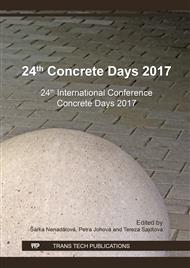p.273
p.280
p.284
p.290
p.299
p.305
p.313
p.319
p.325
Possibility of Increasing the Load Bearing Capacity of Parapet Bridge Structures
Abstract:
Post-tensioning is a suitable, reliable and durable method for strengthening existing reinforced concrete bridge structures. The high efficiency of post-tensioning can be seen on many implemented applications for bridge reconstructions worldwide. There are still several thousands of beam and slab bridges the load capacity of which no longer meets the demanding transport conditions. The oldest reinforced concrete beam bridges, from 1905-1915, are designed according to the Austrian Ministry of Railways Bridge Standard of 1904 when the largest load to be considered was the 18-tonne road steamroller. These bridges are not dimensioned for the currently valid traffic load values. The paper deals with the strengthening of the parapet beam bridges from the period of 1905-1930. These bridges have two main beams pulled over the bridge deck which is supported by cross beams. The cross beams connect the two main beams, forming a half-frame in the transverse direction which provides spatial rigidity of the structure. The spans of these bridges are usually in the range of 15 to 25 m.
Info:
Periodical:
Pages:
319-324
Citation:
Online since:
February 2018
Authors:
Price:
Сopyright:
© 2018 Trans Tech Publications Ltd. All Rights Reserved
Share:
Citation:


